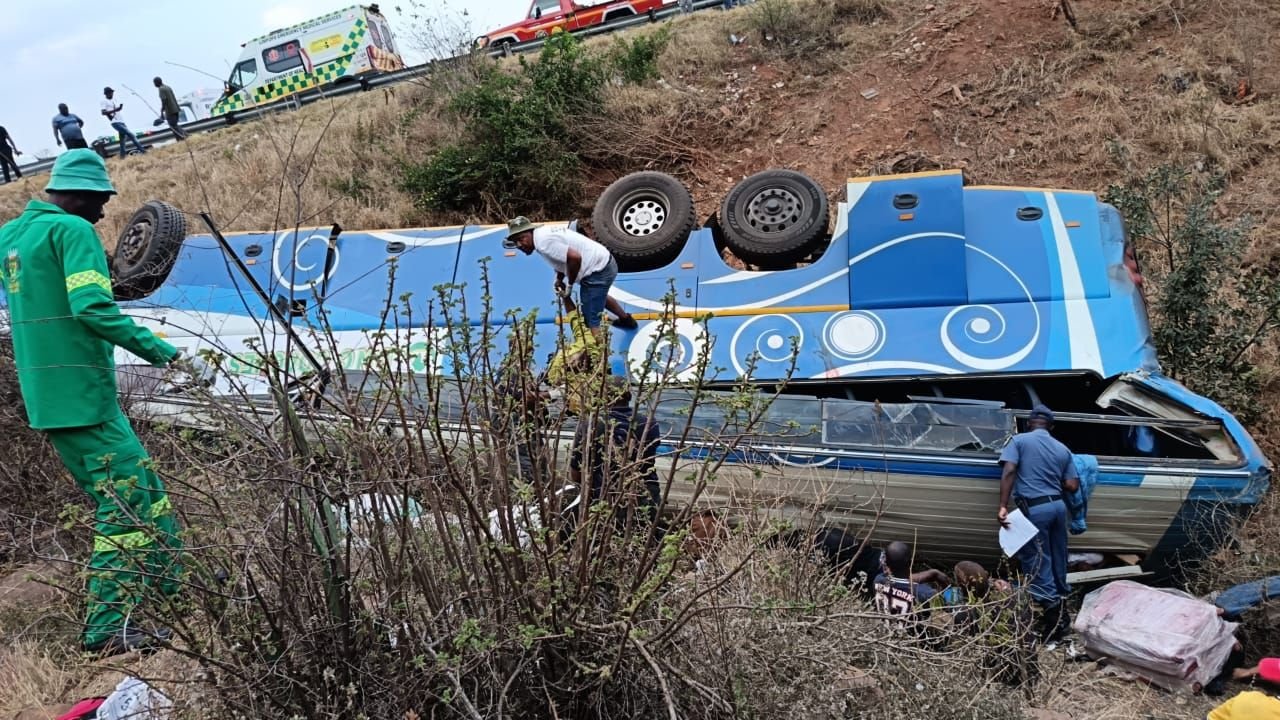At Least 42 Killed in Horrific South Africa Bus Accident on Mountain Road
In one of the deadliest road accidents in recent memory, at least 42 people including seven children lost their lives when a bus veered off a mountain road in South Africa’s Limpopo province on Sunday evening. The tragic incident has sent shockwaves through the region and highlighted ongoing concerns about road safety in the country.
The catastrophic bus accident occurred near the town of Louis Trichardt, approximately 250 miles north of Pretoria, when the vehicle traveling along the N1 highway plunged down an embankment around 6pm. The bus was carrying Zimbabwean and Malawian nationals returning to their home countries when the disaster struck, turning what should have been a journey home into an unimaginable tragedy.
Rescue Operation and Mounting Casualties
Emergency services responded to the scene to find the bus lying upside down on an embankment, creating challenging conditions for rescue workers who scrambled beneath the wreckage in search of survivors. The scale of the tragedy became apparent as the death toll climbed throughout the night, with authorities confirming 42 fatalities by Monday morning.
According to the South African transport ministry, the victims included 18 women and 17 men, along with the seven children. The injured survivors numbered 49, with six people in critical condition and another 31 suffering serious injuries requiring hospitalization across multiple medical facilities. One seriously injured child had to be airlifted to a specialized hospital for emergency treatment.
“The bus was lying upside down on an embankment, with rescuers working beneath it as they searched for survivors,” according to the initial reports from the scene documented by Sky News.
The rescue operation involved multiple agencies working through the night to extract victims from the severely damaged vehicle. The remote mountain location and the position of the wreckage complicated efforts, requiring specialized equipment and personnel to safely reach those trapped inside. The psychological toll on first responders dealing with such a devastating scene cannot be overstated, with many confronting one of the most challenging rescue scenarios of their careers.
As families anxiously awaited news of their loved ones, authorities established emergency hotlines and coordination centers to handle inquiries from distraught relatives across South Africa, Zimbabwe, and Malawi. The international dimension of the tragedy necessitated diplomatic coordination between the three nations, with consular officials working to identify victims and notify next of kin.
Broader Context of South Africa’s Road Safety Crisis
This devastating bus accident represents another grim chapter in South Africa’s ongoing struggle with road safety. The Limpopo province where Sunday’s tragedy occurred was the site of another horrific bus crash just last year that claimed 45 lives when a vehicle veered off a bridge into a ravine. In that previous incident, an eight-year-old girl emerged as the sole survivor, highlighting the particularly vulnerable position of children in such disasters.
President Cyril Ramaphosa addressed the nation regarding the latest tragedy, offering “his deep condolences to the nations of Zimbabwe and Malawi who have lost compatriots.” The president acknowledged the broader significance of the disaster, stating, “This incident is a tragedy for South Africa and our sister states of Zimbabwe and Malawi alike.”
“This sadness is compounded by the fact that this incident has taken place during our annual transport month, where we place a special focus on the importance of safety on our roads,” President Ramaphosa noted in his statement responding to the tragedy.
The timing of the accident during South Africa’s annual transport month adds a layer of irony to the tragedy, as this period is specifically dedicated to promoting road safety awareness and initiatives. This contradiction underscores the challenges facing transportation authorities in implementing effective safety measures across the country’s extensive road network.
The N1 highway where the accident occurred serves as a major transportation artery connecting South Africa with neighboring countries to the north. The mountain roads in this region present particular challenges for drivers, with steep gradients, sharp curves, and changing weather conditions that require heightened vigilance and vehicle maintenance. These geographical factors have contributed to multiple serious accidents in the area over recent years.
For those following this developing story and its implications for transportation policy, comprehensive coverage is available through dedicated platforms monitoring the latest South Africa news, providing ongoing analysis of the government’s response to this tragedy and broader road safety initiatives.
According to the initial report from Sky News, the cause of the crash remains under investigation by transportation authorities. The lack of immediate explanation has raised questions about whether mechanical failure, driver error, road conditions, or other factors contributed to the disaster. The investigation will likely examine the bus’s maintenance records, the driver’s background and hours of service, weather conditions at the time of the accident, and the vehicle’s speed leading up to the incident.
The predominance of international passengers on the bus highlights the complex nature of cross-border transportation in Southern Africa, where economic migration patterns result in frequent long-distance bus travel between countries. These journeys often occur on challenging road networks that test both vehicles and drivers, particularly when traversing mountainous regions like the area where Sunday’s tragedy unfolded.
Road safety advocates have long called for improved regulations governing long-distance bus operations, including more rigorous vehicle inspections, enhanced driver training specific to mountain driving conditions, and stricter enforcement of rest requirements for commercial drivers. The recurring nature of such tragedies suggests that current measures remain insufficient to prevent catastrophic outcomes when things go wrong.
The psychological impact of such a devastating bus accident extends far beyond the immediate victims and their families. Communities across the region, particularly those with members who regularly use similar transportation, are likely experiencing heightened anxiety about road safety. The tragedy may prompt renewed scrutiny of cross-border bus companies and their safety records, potentially influencing travel choices for the thousands who rely on these services for international travel.
As the investigation continues and families mourn their unimaginable losses, the broader conversation about road safety in South Africa and neighboring countries takes on renewed urgency. The patterns emerging from this and previous accidents suggest systemic issues that require coordinated regional solutions rather than isolated national responses. The international dimension of this particular tragedy may provide the impetus for such cooperation, potentially leading to improved safety standards that could prevent similar disasters in the future.
In the coming days, attention will focus on the identification of victims, support for grieving families, and care for the injured survivors facing long recoveries. The tragedy serves as a stark reminder of the fragility of life and the critical importance of transportation safety measures in preventing such catastrophic loss of life on South Africa’s roads.


